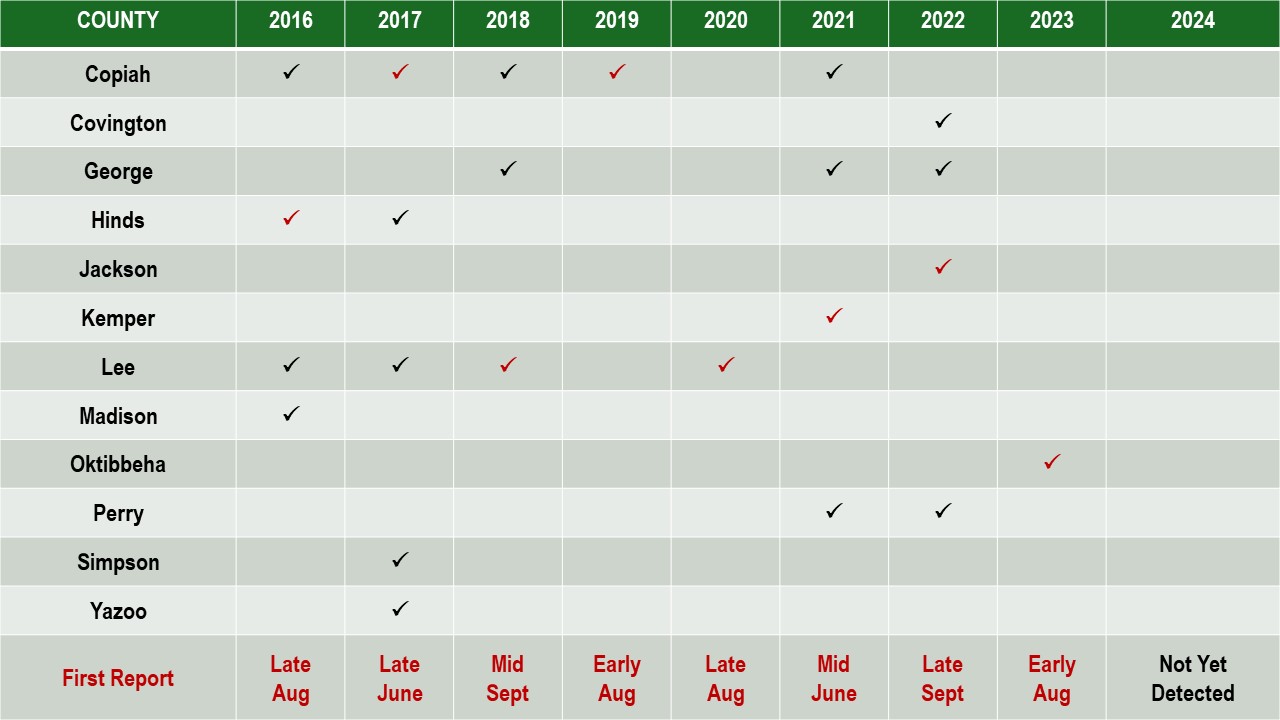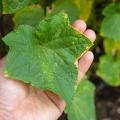Monitoring and Reporting of Cucurbit Downy Mildew in Mississippi
Monitoring and Reporting of Cucurbit Downy Mildew in Mississippi
Photo: Chlorotic lesions on the upper surface of leaves, as seen giving the leaves of the squash plants in this photo a yellow appearance, are symptoms of downy mildew in cucurbits. Credit: R. A. Melanson, MSU Extension, Bugwood.org.
Project Summary: Downy mildew is an important disease that can cause significant losses in cucurbit crops, such as cantaloupe, cucumber, pumpkin, squash, and watermelon. In order for downy mildew to develop, the pathogen must be present along with a susceptible host and favorable environmental conditions. Downy mildew development is favored by high humidity and moderate temperatures. The downy mildew pathogen, Pseudoperonospora cubensis, requires a living host to survive and does not survive in areas where freezing temperatures prevent the survival of cucurbit hosts through the winter. Each year, the pathogen spreads on air currents from areas where it is able to survive through the winter. In an effort to help growers manage downy mildew in cucurbits, a disease forecasting system for downy mildew was developed (CDM ipmPIPE: cdm.ipmpipe.org). This forecasting system is a decision support tool that provides disease forecasts and risk prediction maps to help growers determine the best time for application of fungicides to protect against downy mildew. The disease forecasting system is based on weather forecasts and reports of downy mildew outbreaks. These reports are submitted by university personnel and plant pathologists who confirm the disease on cucurbit samples obtained from farms, gardens, and other plantings. The accuracy of the forecasting system depends on the timely reports of downy mildew outbreaks. In an effort to detect when these outbreaks first occur and when the pathogen reaches an area, sentinel plots may be planted and used to monitor for the occurrence of cucurbit downy mildew. These sentinel plots include varieties of various cucurbit hosts that are susceptible to downy mildew and are monitored weekly for downy mildew development. Sentinel plots are maintained to keep plants as healthy as possible, but fungicides that are effective against downy mildew are not applied. Cucurbit downy mildew sentinel plots were planted and monitored in two locations in Mississippi each year from 2016 to 2022. Additional information about cucurbit downy mildew and the CDM ipmPIPE forecasting system is available below.
Factsheet: Cucurbit Downy Mildew
Photo Guide: A Photo Guide to Cucurbit Downy Mildew (Note: Images alone should not be used to obtain an accurate diagnosis.)
Cucurbit Downy Mildew Forecasting & Reporting Website (CDM ipmPIPE website): Due to a lack of funding, forecasts for downy mildew have been suspended. However, the website is still used to track confirmed reports of downy mildew and can be used to make informed decisions about downy mildew managment. Check out the latest reports and sign up to receive downy mildew alerts in your area here.
Sentinel Plots in Mississippi: Sentinel plots for cucurbit downy mildew were planted each spring and fall from 2016 through 2021 at the Truck Crops Branch Experiment Station in Crystal Springs (Copiah County), in the spring of 2016 and each fall from 2017 through 2021 at the North Mississippi Research and Extension Center in Verona (Lee County), and in 2022 in the spring and fall at the Beaumont Horticulture Unit (Perry County) to monitor for the occurrence of cucurbit downy mildew in Mississippi. Due to weather and limited resources, sentinel plots for cucurbit downy mildew have not been planted in Mississippi since 2023.
Reports of Cucurbit Downy Mildew in Mississippi: Cucurbit downy mildew has been detected each year in Mississippi since 2016, when monitoring efforts for this project began. The disease has most often first been detected in August or September but has been detected as early as mid-June. Downy mildew is commonly observed in fall cucurbit crops in many areas by September. A summary of confirmed reports of cucurbit downy mildew in Mississippi since 2016 is included in the table below. A searchable database for previously confirmed reports of downy mildew in Mississippi is available here; reports list the host, county, date of report, date of first occurrence, and type of planting.

Article of Interest: Citizen Scientists Wanted: Cucurbit Downy Mildew
Videos:
- Identification, Monitoring, and Reporting of Cucurbit Downy Mildew
- Cucurbit Downy Mildew Management for Conventional and Organic Producers
Mississippi Project Collaborator:
- Dr. Rebecca A. Melanson (State Project Leader)
Central MS Research & Extension Center; Raymond, MS
(601) 857-2284
Previous Project Collaborators:
- Dr. Christine Coker, Beaumont Horticultural Unit, Beaumont, MS
- Mike Ely, Beaumont Horticultural Unit, Beaumont, MS
- Dr. Shaun Broderick, Truck Crops Branch Experiment Station; Crystal Springs, MS
- Dr. T. C. Barickman, North Mississippi Research & Extension Center; Verona, MS
- Thomas Horgan, North Mississippi Research & Extension Center; Verona, MS
- Brenton Breland, Truck Crops Branch Experiment Station; Crystal Springs, MS
Acknowledgement: This project was supported between 2018 and 2021 by a United States Department of Agriculture Agricultural Marketing Service Specialty Crop Multi-State Program grant administered by the Pennsylvania Department of Agriculture, PDA No. 44187029, Subaward No. 6060-MSU-PDA-7029. Any opinions or recommendations expressed in this publication do not necessarily reflect the views of any of these organizations.
Publications
News
RAYMOND, Miss. -- Mississippi State University Extension Service plant pathologist Rebecca Melanson was recently recognized for her work to further the development and implementation of integrated pest management in the cucurbit industry. The Emerging Viruses in Cucurbits Working Group, or EVCWG, received the 2024 Friends of IPM Pulling Together Award. Melanson and Bill Wintermantel, a scientist with the U.S. Department of Agriculture, Agricultural Research Service, co-chair the group that was established in 2022.
Did you know the Mississippi State University Extension Service has a laboratory that is designated to diagnose plant diseases and nematodes? Yes, it does! Learn how the Mississippi State University Extension Service Plant Diagnostic Laboratory and its scientists protect the crops that provide our food and fiber along with other home and garden crops.
RAYMOND, Miss. -- Commercial vegetable growers have a new mobile-based resource to help them manage pests and diseases in their crops. The MyIPM for Vegetables app is the latest in the MyIPM app series. MyIPM for Vegetables currently offers resources for tomatoes and cucurbits, which includes cucumbers, pumpkins, squash and watermelons.





